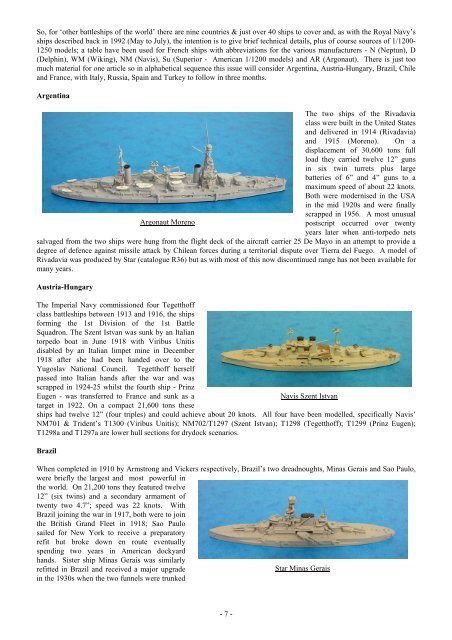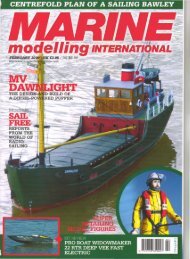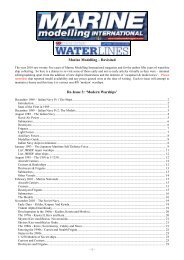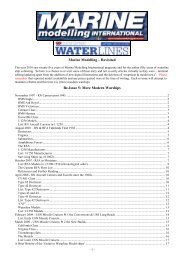Marine Modelling â Revisited Re-Issue 2: 'Foreign Warships'
Marine Modelling â Revisited Re-Issue 2: 'Foreign Warships'
Marine Modelling â Revisited Re-Issue 2: 'Foreign Warships'
Create successful ePaper yourself
Turn your PDF publications into a flip-book with our unique Google optimized e-Paper software.
So, for ‘other battleships of the world’ there are nine countries & just over 40 ships to cover and, as with the Royal Navy’s<br />
ships described back in 1992 (May to July), the intention is to give brief technical details, plus of course sources of 1/1200-<br />
1250 models; a table have been used for French ships with abbreviations for the various manufacturers - N (Neptun), D<br />
(Delphin), WM (Wiking), NM (Navis), Su (Superior - American 1/1200 models) and AR (Argonaut). There is just too<br />
much material for one article so in alphabetical sequence this issue will consider Argentina, Austria-Hungary, Brazil, Chile<br />
and France, with Italy, Russia, Spain and Turkey to follow in three months.<br />
Argentina<br />
The two ships of the Rivadavia<br />
class were built in the United States<br />
and delivered in 1914 (Rivadavia)<br />
and 1915 (Moreno). On a<br />
displacement of 30,600 tons full<br />
load they carried twelve 12” guns<br />
in six twin turrets plus large<br />
batteries of 6” and 4” guns to a<br />
maximum speed of about 22 knots.<br />
Both were modernised in the USA<br />
in the mid 1920s and were finally<br />
scrapped in 1956. A most unusual<br />
Argonaut Moreno<br />
postscript occurred over twenty<br />
years later when anti-torpedo nets<br />
salvaged from the two ships were hung from the flight deck of the aircraft carrier 25 De Mayo in an attempt to provide a<br />
degree of defence against missile attack by Chilean forces during a territorial dispute over Tierra del Fuego. A model of<br />
Rivadavia was produced by Star (catalogue R36) but as with most of this now discontinued range has not been available for<br />
many years.<br />
Austria-Hungary<br />
The Imperial Navy commissioned four Tegetthoff<br />
class battleships between 1913 and 1916, the ships<br />
forming the 1st Division of the 1st Battle<br />
Squadron. The Szent Istvan was sunk by an Italian<br />
torpedo boat in June 1918 with Viribus Unitis<br />
disabled by an Italian limpet mine in December<br />
1918 after she had been handed over to the<br />
Yugoslav National Council. Tegetthoff herself<br />
passed into Italian hands after the war and was<br />
scrapped in 1924-25 whilst the fourth ship - Prinz<br />
Eugen - was transferred to France and sunk as a<br />
Navis Szent Istvan<br />
target in 1922. On a compact 21,600 tons these<br />
ships had twelve 12” (four triples) and could achieve about 20 knots. All four have been modelled, specifically Navis’<br />
NM701 & Trident’s T1300 (Viribus Unitis); NM702/T1297 (Szent Istvan); T1298 (Tegetthoff); T1299 (Prinz Eugen);<br />
T1298a and T1297a are lower hull sections for drydock scenarios.<br />
Brazil<br />
When completed in 1910 by Armstrong and Vickers respectively, Brazil’s two dreadnoughts, Minas Gerais and Sao Paulo,<br />
were briefly the largest and most powerful in<br />
the world. On 21,200 tons they featured twelve<br />
12” (six twins) and a secondary armament of<br />
twenty two 4.7”; speed was 22 knots. With<br />
Brazil joining the war in 1917, both were to join<br />
the British Grand Fleet in 1918; Sao Paulo<br />
sailed for New York to receive a preparatory<br />
refit but broke down en route eventually<br />
spending two years in American dockyard<br />
hands. Sister ship Minas Gerais was similarly<br />
refitted in Brazil and received a major upgrade<br />
Star Minas Gerais<br />
in the 1930s when the two funnels were trunked<br />
- 7 -







